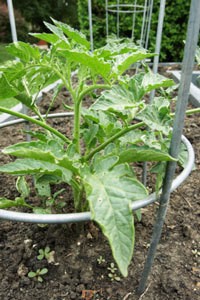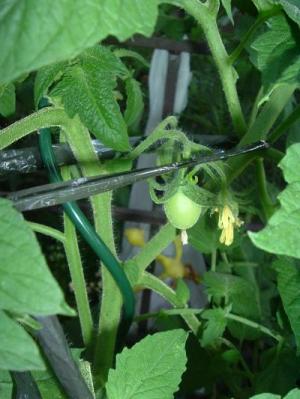 For many gardeners, tomatoes are one of the most prized vegetables in the garden. Whether you grow them in pots on your patio, or directly in your garden, staking them and training them to grow on supports will help reduce the potential of fruit loss due to sunburn, insects, and disease.
For many gardeners, tomatoes are one of the most prized vegetables in the garden. Whether you grow them in pots on your patio, or directly in your garden, staking them and training them to grow on supports will help reduce the potential of fruit loss due to sunburn, insects, and disease.
Indeterminate tomato varieties set their fruit clusters along vines that continue to grow throughout the season. These varieties need to be heavily pruned when trellised (pruned to one main stem and strong sucker below the first bloom cluster), moderately pruned when staked (limited to 2-3 fruit-producing branches), and lightly pruned when using cages (limited to 3 to 5 fruit-producing branches).
The primary benefit of providing tomato plants support is to prevent of fruit loss from soil rot. Tomato plants grown on the ground and without supports can suffer as much as 15-50 percent total fruit loss depending on the variety and the growth habit of the plant.
Staking: Staking is done using a single metal or wooden stake at least 3 to 6 feet long and 1 inch thick. The stakes should be driven 12-18 inches into the ground. The stem of the plant is then secured to the stake with a soft tie. The advantage to using stakes for support is that they are inexpensive and take up very little room. They are also suitable for both determinate and indeterminate varieties of tomato plants.
Caging: Most gardeners are familiar with the circular metal cages made for supporting tomatoes. There are two main advantages to using these pre-made cages. They are quick and easy to maintain, and the fruits from plants grown in cages tend to suffer the least amount of sunburn. As far as disadvantages go, tomato cages are typically the most expensive type of support and take up the largest amount of space per plant.
Trellises: This type of support system is limited to indeterminate varieties. Posts or stakes at least 4 feet high and 4 inches thick are set into the ground approximately 10 to 25 feet apart (depending on the number of plants being grown). A heavy gauge wire is then stretched from one post to around another and back again to create support. Three rows of wire supports strung at 1-1/2 foot, 2-foot, and 3-foot intervals up the post should be adequate for most tomato plants. The advantage of using this support system is that once you set it up it will last for years. Other vine or climbing crops can be routinely rotated in and out of this area to avoid insect and disease problems.
H Supports: This type of support system works especially well for determinate varieties of tomatoes, because it keeps the fruit off the ground without the need for pruning or tying. Create two wooden H supports (think of a capital H) that are 2-3 feet wide and sit 8 to 10 inches off the ground. Place these supports 10 feet apart from each other in the garden so they are centered over your young tomato plants. Lay a piece of wide gauge fencing (like hog wire) across the supports and secure it at both ends. As the plants grow, simply pull them through the opening so the fence supports them.
This page contains the following solutions.
When planting tomato plants in a garden - place hog panel 3 feet tall down the length of the row(s). Plant tomato plants in front of each side of the panel - as they begin grow start to tie them to the panel with cut up nylon hose.
We used a used cattle panel down the middle of our tomato row. Plant recommended distance and vine in as they grow and tie as needed.
When I grow tomatoes, I put the support stake in when I plant the tomato. On the stake, I place 2-3 soft terrycloth hairbands. As the plant grows, I move the bands up and use the bottom one to tie the plant to the stake.
Here are the questions asked by community members. Read on to see the answers provided by the ThriftyFun community.
When tomato plants stems get to high, do they have a tendency to lay down?
By Phyllis from Edmonton, Alberta
It's good to stake up tomato plants when they are younger so when they get bigger they don't do this. You can try staking them up now and if the stems aren't too bent they might recover.
You can also leave them to vine on the ground; however they're more vulnerable to bugs and slugs, and so on there. But commercial growers do this for the tomatoes they grow for canning, etc.
When you buy (or grow) plants, there are "determinate" and "indeterminate" varieties. The determinate ones produce tomatoes that all tend to ripen around the same time. You grow these if you need a large amount all at once; such as if you will be canning or freezing. These plants tend to be shorter, and you can often get away with not staking. (These are what commercial growers use.)
The indeterminate varieties tend to produce over a longer period, and the fruit don't all ripen at once. These varieties are good for eating, or other uses where you don't need so many at once, but want them to be available over a longer period of time. These plants tend to continue growing, and are better staked or caged.
You can stake your plant up now. Just try not to break through the main stem. I like strips cut from worn t-shirts, as they're soft, surprisingly strong, and don't seem to "cut into" the stems.
One caution, while I don't have sensitive skin; if I am tending a lot of tomatoes on a hot day, (when my pores are "open"), I can get a good rash from tomato plants. So if you have sensitive skin, you may want to wear long sleeves.
Yes, you want to keep fruit and leaves up off the ground, but tomatoes aren't natural climbers like ivy - if you don't give them help, they'll sprawl all over the place. Either put a tomato cage around each one, and make sure the main stems grow up inside it, or provide a trellis of some kind and tie them loosely, gently, to the support.
I have used old nylons (knee-highs or the legs from panty hose) and strips of worn-out T-shirts. I got ambitious this year and replaced the stretched-out elastic in my pants, and used that for extra-long ties; that lets me wrap around a stem, around the post, up over the horizontal bar, down around another stem, and tie the ends together - and still give them room to move and grow! (Yes, my pants were pretty big in the waist by the time I got around to this! LOL)
Having used up my elastic waistbands, I cut up a plastic grocery bag for short ties for the less...exuberant plants. Strips of that were enough to wind around a tall slender stem, over the bar and around the pole, and back down to tie. Like the elastic, nylons, and fabric strips, this has enough give and soft edges so it won't strangle or cut the growing stem.
By winding it gently around a stem just below a branch, I make sure the stem doesn't just slump and slide right out of the sling. That can be a problem especially if you don't get them tied up right from the start, and then have to lift thick, heavy stems into a new position - they don't like it much and want to go back to where they were.
What do I use to stake tomato plants in a 5 gal pot or bucket?
By Norm from Plymouth, NH
Staking is done using a single metal or wooden stake at least 3 to 6 feet long and 1 inch thick.I also use reed poles from Lowe's. The stakes should be driven 12-18 inches into the ground. The stem of the plant is then secured to the stake with a soft tie. The advantage to using stakes for support is that they are inexpensive and take up very little room. They are also suitable for both determinate and indeterminate varieties of tomato plants. More info online, good luck.
This year I found at my dollar store the Tomato coil it is a 1/2 inch coiled metal rod about 6 ft. tall and you shove it in the ground or pot and you feed the main stem of the tomato plant up this coil the only problem is I refuse to snip off the side branches so I use VCR tape to pull them in and I tie the tape to the same rod.

OK don't laugh but I used a weed I found at the edge of the woods. I think my neighbor said it was called a golden rod. They are like 4ft tall. I just pulled the leaves off and let it dry out for the day, and poked in down in the pot and tied it up! The neighbor laughed but went and broke him some to use!
Slender bamboo sticks can be used in your garden or containers to stake plants such as tomatoes and flowers. They also work for young trees.
Cut up your old panty hose into strips and use them to tie up your veggie and garden plants. This is a page about use old panty hose to tie up plants.
An A-frame tresses can be easy and inexpensive to make. It is also an excellent structure to help support your climbing plants. This is a page about easy way to string tomatoes, cucumbers, or green beans.